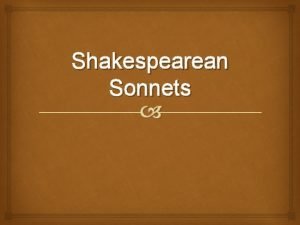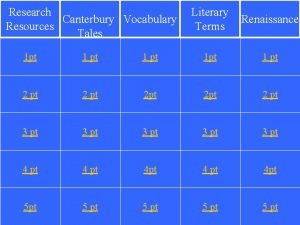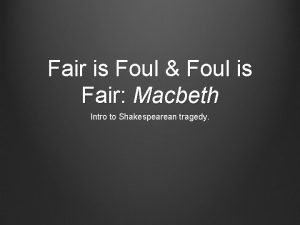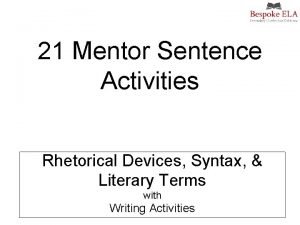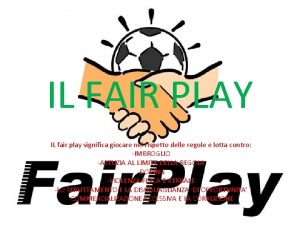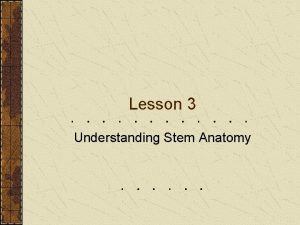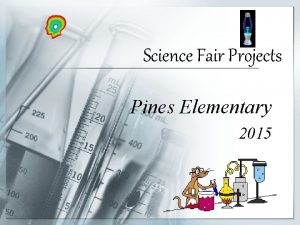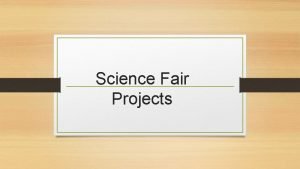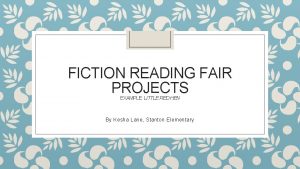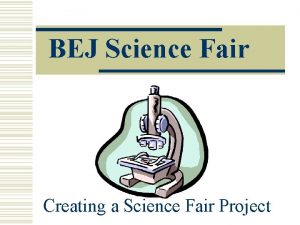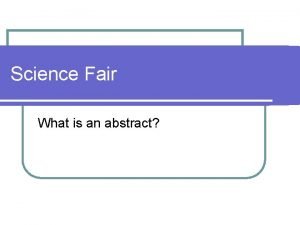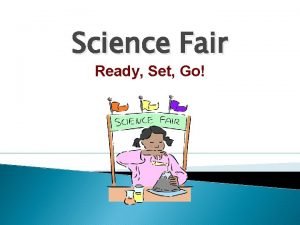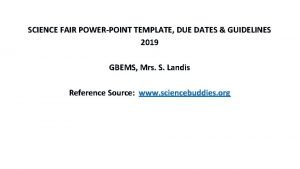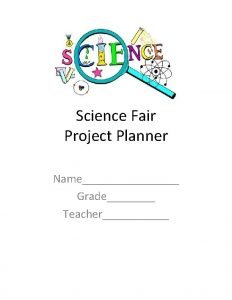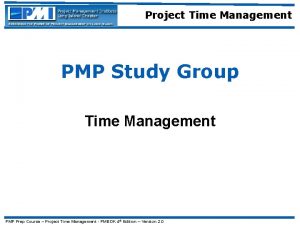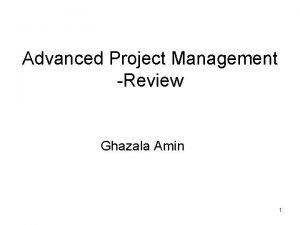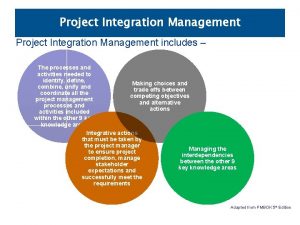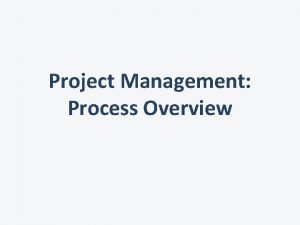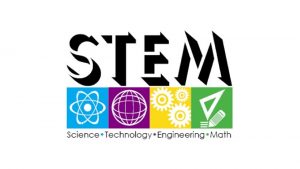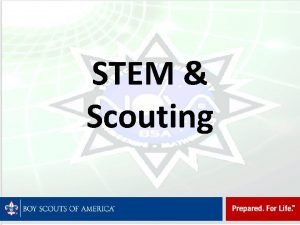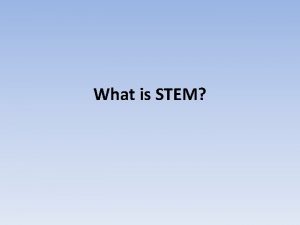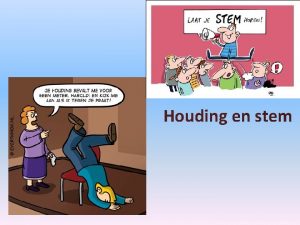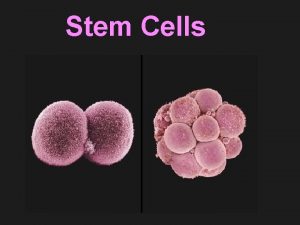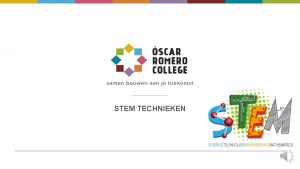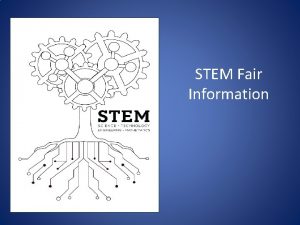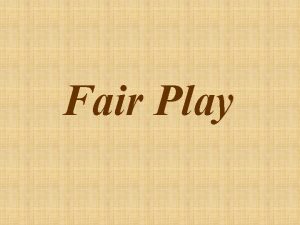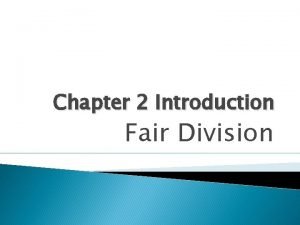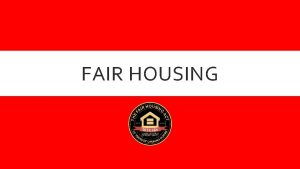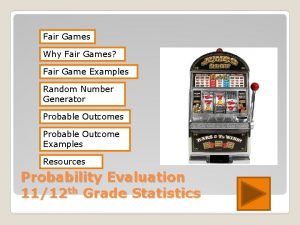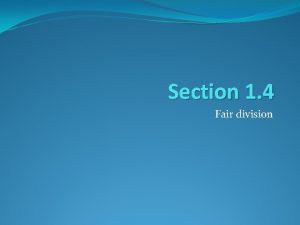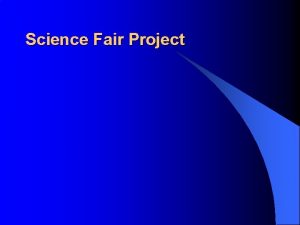Understanding the Three STEM Fair Project Processes Three






































































- Slides: 70

Understanding the Three STEM Fair Project Processes

Three Different Types of Processes to Choose From for a STEM Fair Project The Scientific Method The Engineering Design The Computer Design

The main purpose of the Scientific Method Process is to discover something about nature and connect it to our world. This helps us better understand our world to see why something happens, also to solve or prevent problems.

The main purpose of The Engineering Design Process is to design and build a prototype to have it perform to solve a problem, improve a situation, or to use it in a way where a task is easier to do.

The main purpose of the Computer Design Process is to program a computer for people to learn about new ideas, learn how to do something, find information that they want to know, or for the computer to perform a useful function.

The Scientific Method Process These are the required steps when using the Scientific Method Process. • • Purpose Research Hypothesis Experiment: - Write down the materials you will need -Write the step-by-step instructions you will follow - Write the variables of the experiment - Write what you see happening in the experiment (data). • Analysis • Conclusion

The Scientific Method Projects • This scientific method will be used for the following projects: – Earth & Environmental Projects – Life Science Projects – Physics, Astronomy, and Mathematic Projects – Chemistry Projects – Consumer Science and Product Testing Projects

Earth & Environmental Projects Volcanoes, soil, rocks, minerals, crystals, erosion, weathering, soil deposits, ocean water, earthquakes, fossils, water cycle, weather, air, water, wind, humidity, cold, heat, smog, particles in the water and air, global temperatures, landfills, recycling, composting, any types of pollutants, plant diseases, growing plants organically, and wasting water.

Life Science Experiments Animal, plant, insect, and human behavior; ecosystems such as forests, deserts, grasslands, and wetlands; food chains, plant cycle, and metamorphosis.

Physics, Astronomy, and Mathematics Projects Forces in nature—gravity, magnets, centripetal and centrifugal forces, friction, balanced and unbalanced forces; laws of motion; work; simple machines; forces in gases and liquids; pressure, buoyancy, and lift; energy— heat, light, sound, electricity; rotation, revolution, seasons, tides, gravitation pull, brightness/color of stars, space particles, stars, micrometeorites, and asteroids; proof through math, geometric studies, distances in space, math formulas and calculations to prove ideas.

Chemistry Projects States of Matter-solids, liquids, and gases; mixtures, solutions and suspensions; chemical formulas, reactions, and equations; chemical and physical changes.

Consumer Science and Product Testing Projects • Testing products you see in advertisements. • Testing products against each other to see which is the best such as popcorn, diapers, cereals, gum, soda pop, oil in potato chips or French fries, stain removers, soaps, paper towels, and bandages.

The Designing Method* The designing method will be used for the following projects: – Engineering Design – Computer Science Design

Engineering Design Process These are the required steps when using the Engineering Design Process. • Define a need for you prototype • Research your topic • Establish requirements of what the prototype will do • Design many drawing of your idea – Focus on one drawing for a prototype. – Make a list of the materials – Plan a step-by-step how it is to be built • • Build the model Test the model and analyze the results Redesign, test, and analyze if needed Write a conclusion what you learned

Computer Design Process These are the required steps when using the Computer Design Process. • Define a need for your program • Research your topic • Establish requirements of what the program will do • Design many code ideas – Focus on one code for your program – Plan the step-by-step process – Program your computer with the code. • Test the model and analyze the results • Redesign, test, and analyze if needed • Write a conclusion what you learned

Other Things That are Required When doing a STEM Fair Project • You need to have a STEM fair journal that shows the work you did and your results following the Scientific Method, Engineering Design, or Computer Design. • You need a display board that shows all the steps of the Scientific Method, Engineering Design, or Computer Design. • An interview will be conducted to see if you can explain the Scientific Method, Engineering Design, or Computer Design in reference to the project.

Examples of Projects “What can you do with…. ? ” eggs water flashlights balls straws concentration shoes tastes balloons rubber bands memory newspaper magnets salt colored paper things that float smells different ages ice cubes blindfolding bubbles sponges things that sink music coins soaps noise marbles voices colors evaporation cotton paper airplanes dissolving things animal tricks small cars

Doing A Meaningful Scientific Method STEM Fair Project

Follow the Scientific Method Process While Doing Your STEM Fair Project • On the next few slides are the detailed steps of the Scientific Method Process. • Please follow each step of the Scientific Method Process as completely as you can. • Be sure to do each step. Do not skip any steps. • Write everything you do in your journal.

The Scientific Method Process These are the required steps when using the Scientific Method Process. • • Purpose Research Hypothesis Experiment: - Write down the materials you will need -Write the step-by-step instructions you will follow - Write the variables of the experiment - Write what you see happening in the experiment (data). • Analysis • Conclusion

The STEM Fair Scientific Method Journal Before you begin you need a journal. • STEM fair projects need to show a record of everything done by you as a “scientist” following the Scientific Method. • You need a title page, table of contents, all parts of the Scientific Method, and a bibliography in the journal. • The table of contents will include all the steps of the Scientific Method Process. • Everything you do pertaining to your project will be recorded in your journal including observations and measurements. • Be sure you date each day you work on your project.

What is Your Purpose? • The purpose shows that you are going to solve a problem or find out something you don’t know. Write your purpose in the form of a question in your journal. This is what you want to investigate.

Research Your Topic • Before you begin experimenting, you some background information by using some of these resources: – – – – Encyclopedias Science Magazines Science Textbooks Library Books Internet Interviews Letters Phone Calls • You need to research your topic by using at least three resources. • Record the information you learned about in your journal.

Make a Hypothesis • You are ready to make a prediction of what you think the results of your experiment will be in your journal. • Based on your research, what do you think will happen when you do your experiment? • You also need to put an explanation in your journal as to “why” you chose this hypothesis. • Example: Hypothesis: When light shines on an object, the object will become hotter at a direct angle than on an indirect angle. Explanation: Light shining straight down covers a smaller area than shining on an angle. When on an angle, more heat is spread out causing less heat on the object.

The Experiment List of Materials • At this time you need to make a list in your journal of materials you are going to need for your experiment. • Be sure to make your list very complete with describing words. • Tell of all measurements and quantities you are going to use.

The Experiment Step-by-Step Directions • You need to write the directions of the procedure you are going to follow to do the experiment in your journal. • These directions tell exactly the process you are going to follow as you do your experiment. • As you write your directions in your journal, you have to be sure your test is fair. Keep all the conditions the same each time you do the experiment.

The Experiment Controlled and Experimental Variables • “Variable” means something can change. Everything around us has the possibility of changing so we live among variables. Variables are all the factors that have an effect on your experiment. • You want to control most of the variable so they are called controlled variables. • You only want to change one variable to have a different outcome each time you do your experiment. This is called the experimental variable. • Write your controlled variables and the one experimental variable in your journal.

The Experiment Gathering Data • As you do your experiment, you are going to observe things happening. – Be sure to write down the data you are observing in your journal. This is your raw data. – Organize your raw data into a table in your journal. • Be sure to collect sufficient data to make a reasonable conclusion. • Test your experiment at least twice so it is valid.

Analyzing Your Data To analyze mean to break something up into parts to be able to examine it. That is what you have to do with the data. • The first step in analyzing your data is to make a graph. • A graph is a picture of the results of your experiment. • On a graph the experimental variable is usually written at the bottom. • The measurements are usually written at the left side. • The data is the information on the graph. • Then write a paragraph describing what the graph is telling you. • Be sure to make your graph in your journal with the written analysis.

The Conclusion What Did You Find Out? Write about these ideas in your journal and anything else you can think of. • Write if your conclusion agrees with your hypothesis. • Write what you found out--in other words tell what the data means as it relates hypothesis. • Write what you learned from your experiment. • Write other questions you might have now. • Write what you might do differently next time. • Write what connection your results shows with a real world application which shows a transfer of knowledge. Does what you write show evidences of learning?

Bibliography • Tell each of the resources you used when you did your research. – Resource names – Page numbers – Year of Publication

The Display Board This is your Showcase! You need a display board. • All the steps of the Scientific Method should be on the display board except the research. • Give yourself at least 1 week to make your display board. • Make it: Neat, Creative, Easy to Follow, Errorless (no scribbles), and Informative • Your display board should reflect your journal but may not have as much information as your journal.

The Interview You will be interviewed. • Know these things: – Information you have read about. – All the things you did while following the Scientific Method. – What you learned from your project. – How the projects has helped you better understanding the world around you. – Other questions you now have. – What you would change next time if you did the project again.

Doing A Meaningful Engineering Design STEM Fair Project

Follow the Engineering Design Process While Doing Your STEM Fair Project • On the next few slides are the detailed steps of the Engineering Design Process. • Please follow each step of the Engineering Design Process as completely as you can. • Be sure to do each step. Do not skip any steps. • Write everything you do in your journal.

Engineering Design Process These are the required steps when using the Engineering Design Process. • Define a need for you prototype • Research your topic • Establish requirements of what the prototype will do • Design many drawing of your idea – Focus on one drawing for a prototype. – Make a list of the materials – Plan a step-by-step how it is to be built • • Build the model Test the model and analyze the results Redesign, test, and analyze if needed Write a conclusion what you learned

The STEM Fair Engineering Design Journal Before you begin, you need a journal. • STEM fair projects need to show a record of everything done by you as an “engineer” following the Engineering Design. • You need a title page, table of contents, all parts of the Engineering Design, and a bibliography in the journal. • The table of contents will include all the steps of the Engineering Design Process. • Everything you do pertaining to your project will be recorded in your journal including observations and measurements. • Be sure you date each day you work on your project.

Define a Need • Begin by writing a need for something you want to construct. Be sure to have a purpose. It could be to: – Solve a problem – Improve a situation that needs improvement – Making something that will make work easier to do. • Write it so the need is clearly understood.

Research Your Type of Design • Before you begin designing, you need some background information by using some of these resources: – – – – Encyclopedias Science Magazines Science Textbooks Library Books Internet Interviews Letters Phone Calls • You need to research your topic by using at least three sources. • Record the information you learned in your journal.

Engineering Design Requirements • Based on your research, you now have an idea of what your prototype would look like and its importance. • Write down the design requirements what you expect the prototype to do when it is built and tested. • The requirements will relate to the size, weight, shape, appearance, and physical features, and the performances. • The requirements will also relate to the cost, time, and effort needed to build the prototype.

The Designing of the Prototype Beginning Designs • Begin by brainstorming features that would be necessary for your prototype to have to work according to your requirements. • Make three or four drawings on paper what your design should look for it to achieve the requirements. • Label the parts on the drawings.

The Designing of the Prototype Final Designs • Focus in on one of the designs that you feel will be the best design for the needed requirements of the prototype. • Continue to change the design to get closer to what you think is the best design for the needed requirements. • As you work on the changes it should show progress from design to design. • Label the parts of the designs.

Designing of the Prototype List of Materials • Make a list of all the materials and equipment you will need to build the prototype. • Using descriptive words to describe the materials and equipment is important. • Any materials that are measured should have the measurements included.

Designing of the Prototype Step by Step Instructions • You need to write the step by step directions you will follow to build the prototype. • Use numbers in the directions to tell exactly the order you are going to follow to build the prototype. • As you write your directions in your journal, be very descriptive in your writing so anyone reading it will know exactly what you did.

Building, Testing, Recording and Analyzing the Prototype Building: • Build a prototype according to the design drawings, design requirements, list of supplies, and the step-by-step procedure. • Write about your experience building the prototype in your journal.

Building, Testing, Recording and Analyzing the Prototype Testing and Recording • After the prototype is built, it needs to be tested to see if it works according to the design requirement. • Write down what is actually happening during testing. • Be as descriptive as possible. • Test it two or three times to get accurate data.

Building, Testing, Recording and Analyzing the Prototype Analyzing the Data • Look at your data carefully so see if the results match the design requirements. • Write down what you see that is working well and needs no changing. • Write down what needs to change for the prototype to match the design requirements.

Redesign, Retest, Record Analyze If your prototype didn’t work exactly to the design requirements, you will need to make adjustments. • Redesign in a drawing of what changes you need to make and label the changes. • Keep accurate notes of the changes you needed to make just in case you need to go back and look. • Make the changes on your prototype. • Retest the prototype two or three times and write down what you see happening. • Analyze the data to see if it matches the design requirements.

Redesign, Retest, Record Analyze • If the data match the design requirements, then you are done. • If the data doesn’t match the design requirements, then redesigning, changes to the prototype, testing and recording and analyzing should continue until you are satisfied with the testing results. • Be sure to write down all the changes made and the testing results of each change.

The Conclusion What Did You Find Out? Write about these ideas in your journal and anything else you can think of. • Write did you learn while doing your project? • How did the results validate what was expected to happen? • What did you learned from your project? • In what ways is your prototype important? • What are other questions you have now? • What might you do differently next time if you made one again? • How can the information you learned be applied to real life? Does what you write show evidences of learning?

The Display Board This is your Showcase! You need a display board. • All the steps of the Engineering Design should be on the display board except the research. • Give yourself at least 1 week to make your display board. • Make it: Neat, Creative, Easy to Follow, Errorless (no scribbles), and Informative • Your display board should reflect your journal but may not have as much information as your journal.

The Interview You will be interviewed. • Know these things: – Information you have read about. – All the things you did while following the engineering design. – What you learned from your project. – How the projects has helped you better understanding the world around you. – Other questions you now have. – What you would change next time if you did the project again.

Doing A Meaningful Computer Design STEM Fair Project

Follow the Computer Design Process While Doing Your STEM Fair Project • On the next few slides are the steps of the Computer Design Process. • Please follow each step of the Computer Design Process as completely as you can. • Be sure to do each step. Do not skip any steps. • Write everything you do in your journal.

Computer Design Process These are the required steps when using the Computer Design Process. • Define a need for your program • Research your topic • Establish requirements of what the program will do • Design many code ideas – Focus on one code for your program – Plan the step-by-step process – Program your computer with the code. • Test the model and analyze the results • Redesign, test, and analyze if needed • Write a conclusion what you learned

The STEM Fair Computer Design Journal Before you begin, you need a journal. • STEM fair projects need to show a record of everything done by you as a “computer programmer” following the Computer Design. • You need a title page, table of contents, all parts of the Computer Design, and a bibliography in the journal. • The table of contents will include all the steps of the Computer Design Process. • Everything you do pertaining to your project will be recorded in your journal. • Be sure you date each day you work on your project.

Define a Need • Begin by writing a need and/or purpose for the program you want to develop. • It could be something that you: – Want people to learn – Want people to know – Help to learn something in an easier way. – To perform a useful function. • Write it so the need is clearly understood.

Research Your Type of Design • Before you begin designing, you need some background knowledge about your subject. Use some of these resources: – – – – Encyclopedias Science Magazines Science Textbooks Library Books Internet Interviews Letters Phone Calls • You need to research your topic by using at least three sources. • Record the information you learned in your journal.

Computer Design Requirements • Based on your research, you now have an idea of what type of program you want to code and its importance. • Establish the requirements needed for the development of the program code and what you expect it to do. – You need to decide how the program code will be designed and how the final program will perform. It will mean: • How much memory you will need. • What the program will be able to do. • What the final outcome the program will help with. • The accuracy of the performance. • The program will need to be tested to see if the desired results came about.

Designing the Program Code Beginning Designs • Begin by brainstorming program codes that might work according to your requirements. • Write three or four codes that you feel would have the same desired results. • Focus on one that you think would be he best.

Designing the Program Code Final Designs • As you focus on one, continue to write up a series of operations for the program code. • You are to show the changes in the development of the program code tweaking it as you get closer to the desired results. • The code development needs to show progress as you work on it.

Putting the Code Into the Computer • When you have finished designing the code, you need to put this code into your computer. • If you have decided to change the code while doing this, then go back into the design and show your changes. • Begin again and put the final code into your computer. • Write about your programming experience in your journal.

Testing, Recording and Analyzing the Code Results Testing and Recording • After coding your computer, the code needs to be tested to see if it works according to the design requirement. • Run the computer program using the code. Write down what is actually happening during testing. • Be as descriptive as possible. • Test it two or three times to get accurate data.

Testing, Recording and Analyzing the Code Results Analyzing the Data • Look at your data carefully to see if the results match the design requirements. • Write down what you see that is working well and needs no changing. • Write down what needs to change for the program results to match the design requirements.

Redesign, Retest, Record Analyze If your program didn’t work exactly to the design requirements, you will need to make adjustments. • Redesign by changing the code as to the notes you took in your journal. • Keep accurate notes of the changes you needed to make just in case you need to go back and look. • Make the changes on your computer by changing the code. • Retest the program two or three times and write down what you see happening. • Analyze the data to see if it matches the design requirements.

Redesign, Retest, Record Analyze • If the results match the design requirements, then you are done. • If the results don’t match the design requirements, then redesigning, changes to the code, testing, recording and analyzing should continue until you are satisfied with the tested results. • Be sure to write down all the changes made and the testing results of each change.

The Conclusion. What Did You Find Out? Write about these ideas in your journal and anything else you can think of. • Write did you learn while doing your project? • How did the results validate what was expected to happen? • What did you learned from your project? • In what ways is your new program important? • What are other questions you have now? • What might you do differently next time if you made one again? • How can the information you learned be applied to real life? Does what you write show evidences of learning?

The Display Board This is your Showcase! You need a display board. • All the steps of the Computer Design should be on the display board except the research. • Give yourself at least 1 week to make your display board. • Make it: Neat, Creative, Easy to Follow, Errorless (no scribbles), and Informative • Your display board should reflect your journal but may not have as much information as your journal.

The Interview You will be interviewed. • Know these things: – Information you have read about. – All the things you did while following the computer design. – What you learned from your project. – How the projects has helped you better understanding the world around you. – Other questions you now have. – What you would change next time if you did the project again.

Thoroughness • Follow through with these ideas: – – – Goals of the project Creativity in the design Clarity Appropriate methods Appropriate equipment Appropriate grade level Knowledge Enthusiasm Individual effort Completed journal Creative display board
 14 lines of shakespeare
14 lines of shakespeare Foul is fair and fair is foul literary device
Foul is fair and fair is foul literary device Not so happy yet much happier literary device
Not so happy yet much happier literary device Foul is fair macbeth
Foul is fair macbeth Syntax literary device
Syntax literary device Fair is foul and foul is fair significato
Fair is foul and foul is fair significato Examples of fair is foul and foul is fair in macbeth
Examples of fair is foul and foul is fair in macbeth Concurrent processes are processes that
Concurrent processes are processes that Sac stem fair
Sac stem fair Understanding stem anatomy
Understanding stem anatomy Function of stem in plants
Function of stem in plants Tooth decay science fair project graph
Tooth decay science fair project graph Science fair project log book template
Science fair project log book template What is abstract in a science project
What is abstract in a science project Paper airplane science fair
Paper airplane science fair Components of a science fair project
Components of a science fair project Reading fair examples
Reading fair examples Agriscience fair project ideas
Agriscience fair project ideas Optical illusions science fair project hypothesis
Optical illusions science fair project hypothesis Science fair definition
Science fair definition Science fair timeline
Science fair timeline Science fair template powerpoint
Science fair template powerpoint Science fair project planner
Science fair project planner Ffa agriscience fair ideas
Ffa agriscience fair ideas Project time management definition
Project time management definition Project management processes
Project management processes Focusing on broad organizational needs
Focusing on broad organizational needs Six processes of project integration management
Six processes of project integration management A process consists of one or more
A process consists of one or more What are two basic requirements for a healthy scalp
What are two basic requirements for a healthy scalp Stem 3 little pigs
Stem 3 little pigs Hình ảnh bộ gõ cơ thể búng tay
Hình ảnh bộ gõ cơ thể búng tay Frameset trong html5
Frameset trong html5 Bổ thể
Bổ thể Tỉ lệ cơ thể trẻ em
Tỉ lệ cơ thể trẻ em Chó sói
Chó sói Tư thế worms-breton
Tư thế worms-breton Chúa yêu trần thế alleluia
Chúa yêu trần thế alleluia Các môn thể thao bắt đầu bằng từ đua
Các môn thể thao bắt đầu bằng từ đua Thế nào là hệ số cao nhất
Thế nào là hệ số cao nhất Các châu lục và đại dương trên thế giới
Các châu lục và đại dương trên thế giới Công thức tính độ biến thiên đông lượng
Công thức tính độ biến thiên đông lượng Trời xanh đây là của chúng ta thể thơ
Trời xanh đây là của chúng ta thể thơ Mật thư tọa độ 5x5
Mật thư tọa độ 5x5 Làm thế nào để 102-1=99
Làm thế nào để 102-1=99 Phản ứng thế ankan
Phản ứng thế ankan Các châu lục và đại dương trên thế giới
Các châu lục và đại dương trên thế giới Thơ thất ngôn tứ tuyệt đường luật
Thơ thất ngôn tứ tuyệt đường luật Quá trình desamine hóa có thể tạo ra
Quá trình desamine hóa có thể tạo ra Một số thể thơ truyền thống
Một số thể thơ truyền thống Bàn tay mà dây bẩn
Bàn tay mà dây bẩn Vẽ hình chiếu vuông góc của vật thể sau
Vẽ hình chiếu vuông góc của vật thể sau Nguyên nhân của sự mỏi cơ sinh 8
Nguyên nhân của sự mỏi cơ sinh 8 đặc điểm cơ thể của người tối cổ
đặc điểm cơ thể của người tối cổ V cc cc
V cc cc Vẽ hình chiếu đứng bằng cạnh của vật thể
Vẽ hình chiếu đứng bằng cạnh của vật thể Phối cảnh
Phối cảnh Thẻ vin
Thẻ vin đại từ thay thế
đại từ thay thế điện thế nghỉ
điện thế nghỉ Tư thế ngồi viết
Tư thế ngồi viết Diễn thế sinh thái là
Diễn thế sinh thái là Các loại đột biến cấu trúc nhiễm sắc thể
Các loại đột biến cấu trúc nhiễm sắc thể Các số nguyên tố
Các số nguyên tố Tư thế ngồi viết
Tư thế ngồi viết Lời thề hippocrates
Lời thề hippocrates Thiếu nhi thế giới liên hoan
Thiếu nhi thế giới liên hoan ưu thế lai là gì
ưu thế lai là gì Khi nào hổ mẹ dạy hổ con săn mồi
Khi nào hổ mẹ dạy hổ con săn mồi Sự nuôi và dạy con của hươu
Sự nuôi và dạy con của hươu Hệ hô hấp
Hệ hô hấp
